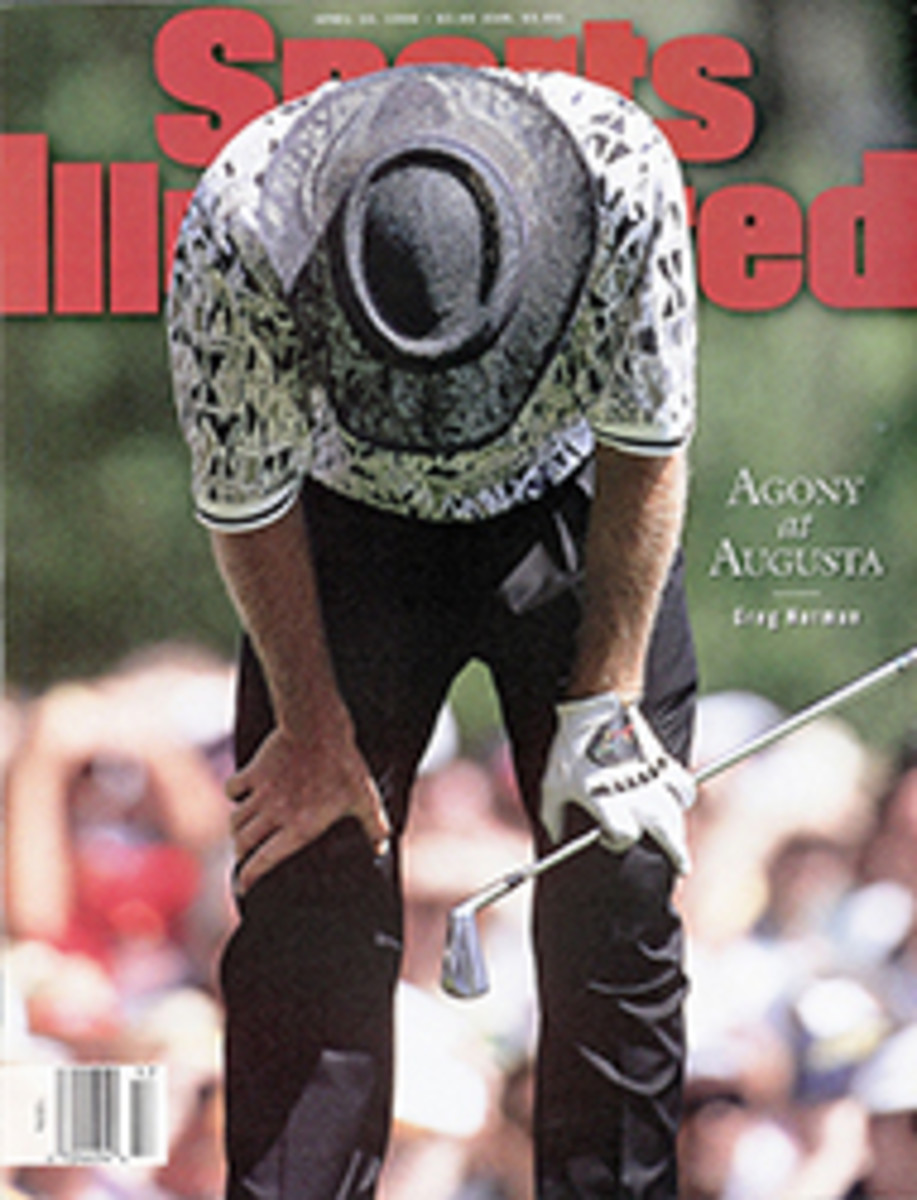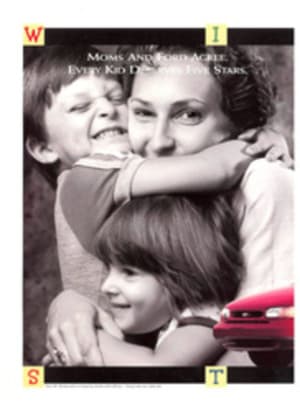
KOSTIS SAW IT COMING AND SAID SO, MUCH TO NORMAN'S DISMAY THE KEY MAN AT AUGUSTA VENTURI TO RE-UP
PREDICTING THE FALL
Greg Norman's demise was tough to watch, even for the guys who
get paid to do it. Ben Crenshaw, serving as a color analyst for
CBS during Sunday's telecast of the Masters, excused himself
from Butler Cabin after Norman followed three successive bogeys
by hitting a seven-iron into Rae's Creek and double-bogeying the
12th hole. When Crenshaw didn't return, a worried Bill Macatee,
with whom he had been working, went looking for him. He found
him outside smoking cigarettes and fighting back tears. "Greg is
such a good guy," Crenshaw said. "This is so hard to watch."
Although Norman might not believe it, Peter Kostis didn't enjoy
seeing the Shark go belly-up either. During Saturday's telecast,
Kostis astutely observed that it appeared that Norman was
fighting his swing and that he had turned a 76 or a 78 into a 71
by making good decisions and relying on an airtight short game.
Kostis later repeated his take on Norman to Brian Hammonds of
the Golf Channel, who paraphrased his comments on the air that
night. Norman happened to catch the Hammonds segment, and he hit
the ceiling. On Sunday morning, before preparing for the final
round, Norman called CBS producer Frank Chirkinian and told him
in no uncertain terms what he thought of Kostis's opinion.
Late on Sunday, Kostis said it was all a misunderstanding. "It
wasn't meant to be a prognostication of doom for Greg," Kostis
said. "Certain things are pretty much cast in stone as far as
golf is concerned. One is that it's very difficult when you're
missing it both ways. Greg hit it right at 9 and 11 on Saturday,
and he hit it left at 15 and 18. I know he was working on a
stronger grip, and he obviously looked uncomfortable. He was
fighting his driver. I meant what I said to be a compliment.
What it does do is leave a million unanswered questions."
One of which has to be: Will Butch Harmon, the swing coach
Norman ditched after last season but brought back to help him
prepare for the Masters, take the fall for his man's collapse?
Harmon sounded more like a football coach than a golf instructor
on Sunday night. "There's nothing I can say right now," he said.
"I've got to look at the tapes and talk to Greg and see how he
felt."
UP THE CREEK
Michael Campbell was the first player at the Masters to benefit
from the lower water level in Rae's Creek in front of the 13th
green, the one major change made to the course this year.
Campbell hit a six-iron into the hazard, and in years past, when
the creek was full, he would have been forced to take a penalty
stroke and a drop. But because the creek bed now has just a
small stream flowing through it, Campbell's ball was only
half-submerged, and he opted to play out. "I just closed my
eyes, and the ball came out to 10 feet," Campbell said. He made
the putt for birdie.
As the tournament progressed, more and more players went for the
green of the par-5 hole in 2, knowing that if they came up short
they might catch a lie either in the creek or on its banks.
Ninety-nine players reached the 13th in two shots during the
week, and while the 485-yard hole played the same statistically
as last year, the added option was a hit.
"I like it much better this way," said Mark Calcavecchia despite
a bogey from the ditch on Thursday. "At least it gives you a
chance."
KEY MAN AT THE NATIONAL
Frank Carpenter is the keeper of the keys at Augusta National,
the man who has total access to the cedar closets where the
members' famous green jackets are stored, and the club's
excellent, although not as well-known, wine cellar below the
kitchen. "My job is to provide service for the members," says
the 69-year-old Carpenter. "I want to be the best sommelier in
the world."
Carpenter started at the National in 1953 as a barman for the
beverage cart between the 9th green and 10th tee. In 1972 he
became the club's steward. His primary responsibility is keeping
an inventory of the 10,000 bottles of wine, a collection that
ranges from a $25 Mondavi Reserve Fume Blanc to a $300 Chateau
Petrus Pomerol. "The strength of this cellar is the quantity of
quality wines," says Carpenter, who is often called upon to
select bottles for special occasions. His challenge last week:
finding something to accompany the Texas barbecue Ben Crenshaw
served at the champions dinner. Lone Star would have been an
excellent choice, but Carpenter eventually settled on eight
bottles of 1975 Lafite Rothschild and four bottles of 1991
Chevalier Montrachet.
As club steward Carpenter is also part of the Masters tradition.
He is responsible for presenting the green jacket to the
defending champion, who in turn puts it on the tournament
winner. "He's a fixture," says Harden Perry, the club's
assistant manager. "Everybody who comes here knows Frank."
COAT TALES
The green jacket worn by Masters champions and Augusta National
members would cost about $200, unadorned, at Brooks
Brothers--and Mr. Blackwell would take away style points for its
55% polyester, 45% wool blend--but stitch on the famous logo and
add the three buttons initialed ANGC and the outdated green
blazer becomes the most stylish little number in golf.
Only members are allowed to purchase the jackets, and the club
prefers that they not take them off the grounds. Made by
Hamilton Tailoring of Cincinnati, the coats are worn for dinner
at the club and during the Masters so that a member can be
easily identified, in the words of the club's late chairman,
Clifford Roberts, as "a reliable source of information" for
tournament patrons. Masters champions get their jackets free,
and are allowed to take them home for one year. The club asks
that the jacket not be worn in commercial endeavors. Jack
Nicklaus, for example, got written permission to be shown in his
in an SI photograph when he was named our 1978 Sportsman of the
Year. Twelve years later Nick Faldo got in hot water when he
allowed TV talk-show host Terry Wogan to try on the coat during
an interview.
Fitting the Masters champions is an inexact science. When it
comes down to one or two contenders on Sunday, the club's
general manager guesses the size of the potential winner, and an
employee hustles to one of two cedar closets where the members'
jackets are stored, picks out a coat and brings it to Butler
Cabin for the presentation. From there, the loaner jacket is
brought to the 18th green by Carpenter, who hands it to the
defending champion, who puts it on the winner.
Not that everything goes without a hitch. When Nicklaus won his
first Masters, in 1963, he was presented with a 46 long by
Arnold Palmer. "I wore a 43 regular," says Nicklaus. "The
sleeves covered my hands." Then someone forgot to have a
permanent jacket made for Nicklaus. When he came back for the
champions dinner in 1964, he was given the jacket belonging to
Thomas Dewey, which Nicklaus wore for 12 years. Nicklaus
eventually called Hart, Schaffner & Marx, the apparel company he
represents, to have a coat made. "That's what I've got upstairs
right now," he says.
Two years ago, when Nicklaus told Masters chairman Jack Stephens
about his bootleg jacket, Stephens offered to have an official
one made. Nicklaus said no, that would only spoil a good story.
"I'm the only guy to win six green jackets, and I don't own one
from the club," Nicklaus says. "I bought my own."
SHORT GAME
CBS will announce a two-year contract extension with analyst Ken
Venturi this week....The Masters remains the only major in which
no player has shot four rounds in the 60s....Seve Ballesteros
and Gary Player had a menu from the champions dinner autographed
by everyone there and sent to Jose Maria Olazabal, who was
unable to play due to rheumatoid arthritis in his feet.... Two
hundred and sixty-one. That's the combined age of honorary
Masters starters Gene Sarazen (94), Byron Nelson (84) and Sam
Snead (83)....Raymond Floyd, 53, became the oldest player to
score a hole in one in the Masters when he aced the 16th hole
with a five-iron on Sunday....Nicklaus's eagle on Saturday at
the 15th was his ninth at that hole....Twenty years ago Jay Haas
won the par-3 contest on the eve of the Masters as a 22-year-old
amateur; last week he won it again.
COLOR PHOTO: JACQUELINE DUVOISIN Lowering the water level in the creek at the 13th allowed Campbell to make a great escape. [Michael Campbell golfing in Rae's Creek at Augusta National Golf Course]
TWO COLOR PHOTOS: BOB MARTIN (2) Carpenter holds the key to the green jackets (above) and the club's 10,000-bottle wine cellar. [Frank Carpenter with green jackets; wine cellar at Augusta National Golf Course]

